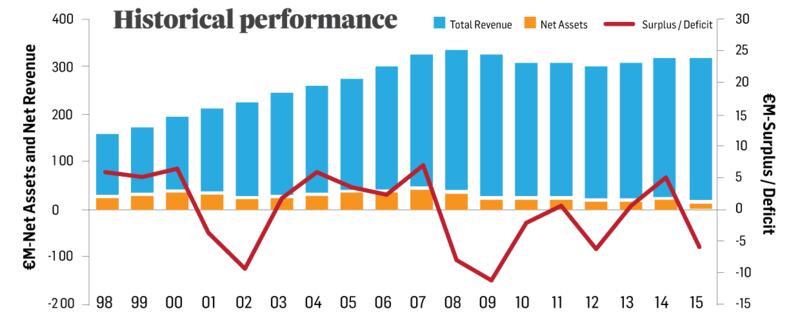Last month Minister for Transport Shane Ross warned the Cabinet that very serious and unpopular decisions may have to be made to address a looming financial crisis at State-owned Bus Éireann. There were suggestions that several routes could have to be shelved.
However, a confidential consultancy report suggests that more radical surgery may be required, and that Bus Éireann may ultimately have to get out of commercial bus operations completely.
Bus Éireann has about 2,600 staff, and in essence has three divisions; the commercial Expressway inter-city services, the State-subsidised routes that operate within cities and between towns, and the school transport services.

The State-subsidised public service operations make a relatively small amount of money, forecast at about €700,000, this year, but the real financial difficulties centre on Expressway.
Over recent years, as more commercial bus licences were issued, Bus Éireann has faced growing competition from private operators, often with a lower cost base, on previously lucrative inter-city routes.
Last autumn The Irish Times reported that management at Bus Éireann had drawn up radical plans to separate Expressway, which lost close to €6 million, from the rest of the company. There would be cuts to the number of staff employed and inferior terms and conditions introduced for those remaining.
A row subsequently developed as to whether Ross had given approval for such restructuring plans.
Survival options
However, the draft report on survival options for the company by consultants
Grant
Thornton suggests that the Department of Transport has been closely involved over recent years in dealing with plans to address the company’s financial difficulties.
“The major contributor to the falling profits has been the commercial services [Expressway] and given its historical cost base and structure, it has struggled to compete with new market entrants with lower cost bases,” the report says.
“Recognising this fact, in recent years management has worked to cut costs across the company, and in 2014 commenced the process of preparing reconstruction plans to reduce its largest cost, payroll, with the hope of putting the company on the path towards a sustainable future.
“Over the past number of years the various options were discussed with the stakeholders but were not progressed due to concerns of industrial unrest across the wider [CIÉ] group.”
The draft report says that in 2015 Bus Éireann management was asked by the “stakeholders” to prepare a plan which avoided large-scale industrial relations unrest.
This plan was presented to the Department of Transport early last year, and although NewEra (the State organisations charged with assisting in the development of key economic infrastructure) had verified the accuracy of the underlying figures on behalf of the Department of Transport, the proposal was rejected “on the basis of cost and payback period”.
Three scenarios
The draft report says that afterwards Bus Éireann management was asked to prepare a further “existence” plan based on three scenarios; doing nothing, exiting from Expressway completely and restructuring Expressway.
Grant Thornton was commissioned last autumn to review management's proposals.
The consultants say that doing nothing is not viable, and could see the company being insolvent in two years.
The consultants also have concerns about management’s restructuring plans which would have involved subcontracting six existing Expressway routes as well as changing terms and conditions for staff.
The management plans for restructuring have never been released in full but the draft consultants’ report gives some details.
Under the proposals 90 of the existing 381 Expressway drivers would be affected by the subcontracting of the six routes.
The company forecasts that 45 of these would take redundancy, 13 would retire and 32 would be reallocated within the CIÉ group.
Of the remaining 291 drivers, the company envisaged that 147 would take a redundancy deal, 10 would retire, 31 would be moved elsewhere within the group and 60 would transfer to a new separate company. It says 43 would become “legacy or hold-out” staff.
A total of 188 new drivers would have to be recruited, presumably on inferior terms. The company envisaged that its initiatives would result in savings per driver of €4,566.
The report suggests that inspectors on Expressway service would have to take a redundancy package, and that a severance scheme of seven weeks per year of service in addition to statutory entitlements with no limits would be needed.
Management estimated that the restructuring proposals could cost more than €23 million.
Operational risks
However, Grant Thornton argues that there are significant financial and operational risks involved. It says there is no clear line of sight on a return on the investment required.
The consultants’ report says 516 jobs would go if Bus Éireann got out of the Expressway business completely.
Redundancy costs, it says, would range from €36million to €85 million depending on the severance terms.
The consultants say the risks of implementing the restructuring and the Expressway closure proposals are not materially different. Given a straight choice, exiting Expressway represented the most viable option given the relative certainty involved, the report says.
The consultants’ report also suggests that other options could be examined to adopt the restructuring plans on a more incremental basis and to try to grow revenue from the State-subsidised parts of the business as well as from the school transport scheme.
However, in conclusion Grant Thornton says that if it becomes apparent that it is not possible to return the company and more particularly the commercial Expressway service to profitability, then getting out of the Expressway business is the only viable option.










